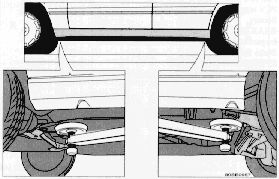
| Volvo service |
| pg. 8:1 Volvo Service |
Service - an investment!
An investment which will pay dividends in the form of improved reliability,
durability, and resale value.
| 8:2 | Label Information |
| 8:3 | Maintenance service, Warranty |
| 8:4 | Maintenance schedule |
| 8:6 | Servicing |
| 8:9 | Lubrication |
| 8:10 | Engine oil |
| 8:12 | Power steering fluid, Brake/clutch system fluid reservoir |
| 8:13 | Automatic transmission fluid |
| 8:14 | Drive belt, Air pump system |
| 8:15 | Windshield washer nozzle, Washer fluid reservoir |
| 8:16 | Coolant |
| 8:17 | Engine compartment |
| pg. 8:2 Label information |
1 Vehicle Emission Control Information
Your Volvo is designed to meet all applicable emission standards, as
evidenced by the certification label on the underside of the hood. For
further information regarding these regulations, please consult your Volvo
retailer.
2 Vacuum hose routing
(underside of hood)
3 Loads and Tire Pressures
(on inside of fuel tank cover)
4 Model plate
Vehicle Identification Number (VIN). Codes for color and upholstery
etc. This plate is located on panel above right headlight.
5 Vehicle Identification Number (VIN) *
The VIN plate is located on the top left surface of the dashboard.
The VIN is also stamped on the right hand door pillar.
6 Federal Motor Vehicle Safety Standards (FMVSS) specifications (USA)
and Ministry of Transport (CMVSS) Standards (Canada)
Your Volvo is designed to meet all applicable safety standards, as
evidenced by the certification label on the facing side of the driver's
door. For further information regarding these regulations, please consult
your Volvo retailer.
7 Child safety latch label
* The Vehicle Identification Number (VIN) should always be quoted in
all correspondence concerning your vehicle with the retailer and when ordering
parts.
** These decals are located on the underside of the hood.
All specifications are subject to change without notice.
| pg. 8:3 Maintenance service, Warranty |
Maintenance service
Volvo advises you to follow the service program which is outlined in the "Maintenance Records Manual". This maintenance program contains inspections and services necessary for the proper function of your car. The maintenance services contain several checks which require special instruments and tools and therefore must be performed by a qualified technician. To keep your Volvo in top condition, specify time tested and proven Genuine Volvo Parts and Accessories.
The Federal Clean Air Act - U.S.
The Clean Air Act requires vehicle manufacturers to furnish written instructions to the ultimate purchaser to assure the proper functioning of those components that control emissions. The maintenance instructions listed in the "Servicing" section of this Manual represent the minimum maintenance required. These services are not covered by the warranty. You will be required to pay for labor and material used. Refer to your Warranty booklet for further details.
Maintenance services
Your Volvo has passed several major inspections before being delivered to you, according to Volvo specifications. The maintenance services outlined in this book should be performed as indicated. The extended maintenance service intervals make it even more advisable to follow this program. Inspection and service should also be performed any time a malfunction is observed or suspected. It is recommended that receipts for vehicle emission services be retained in the event that questions arise concerning maintenance. See your "Maintenance Records Manual".
Applicable warranties - U.S.
In accordance with U.S. Federal Regulations, the following list of applicable
U.S. warranties is provided. For Canadian specification vehicles, see your
separate warranty booklet.
• New Car Limited Warranty
• Parts and Accessories Limited Warranty
• Corrosion Protection Limited Warranty
• Seatbelt and Supplemental Restraint Systems Limited Warranty
• Emission Design and Defect Warranty
• Emission Performance Warranty
These are the Federal warranties; other warranties are provided as required
by state law. Refer to your separate Warranty booklet for detailed information
concerning each of the warranties.
| pg. 8:4 Servicing |
Maintenance schedule
A = Adjust (Correct if necessary) I = Inspect (Correct or Replace if
necessary)
R = Replace L = Lubricate
| Maintenance Operation thousand miles (thousand km) | 5 3
(8) |
10
(16) |
15 3
(25) |
20
(32) |
25 3
(40) |
30
(48) |
35 3
(56) |
40
(64) |
45 3
(72) |
50
(80) |
55 3
(88) |
60 2
(96) |
| EMISSION SYSTEM MAINTENANCE | ||||||||||||
| Engine oil and filter 1 | R 3 | R | R 3 | R | R 3 | R | R 3 | R | R 3 | R | R 3 | R |
| Engine drive belt accessory belt) | R | |||||||||||
| Air cleaner filter | R | R | ||||||||||
| Spark plugs | R | R | ||||||||||
| Automatic transmission fluid | I | I | I | I | I | I | ||||||
| Timing belt - B 5254 S, B 5234 T 4 |
1) See section "Engine oil" for detailed information.
NOTE: The oil should be changed at these intervals or after 750 hours of driving or after 12 months which ever occurs first. See "Service Reminder indicator", page 1:5 of users manual.
2) For services beyond 60,000 miles (96,000 km), consult your "Maintenance
records booklet".
3) These intervals may apply, depending on actual driving conditions
(see page 8:11 for details)
4) For proper functioning of the vehicle and its emission control system,
Volvo recommends that the timing belt be replaced every 70,000 (112,000
km).
| pg. 8:5 Servicing (cont.) |
Maintenance schedule
A = Adjust (Correct if necessary) I = Inspect (Correct or Replace if
necessary)
R = Replace L = Lubricate
| Maintenance Operation thousand miles
(thousand km) |
10
(16) |
20
(32) |
30
(48) |
40
(64) |
50
(80) |
60
(96) |
| ENGINE SYSTEM MAINTENANCE | ||||||
| ENGINE | ||||||
| Fuel (Line) Filter¹ | ||||||
| PCV Nipple (orifice)/hoses,clean | I | |||||
| Battery | I | I | I | I | I | I |
| BRAKES | ||||||
| Inspect brakes, replace components as necessary | I | I | I | I | I | I |
| Brake Fluid² | ||||||
| STEERING/SUSPENSION | ||||||
| Rotate tires/check wear (align front end if needed.) | I | I | I | I | I | I |
| Check power steering fluid level. | I | I | I | I | I | I |
| Grease front link arm stops | L | L | L | L | L | L |
| BODY | ||||||
| Power antenna (clean) | I | I | I | I | I | I |
| Trunk/hood, hinges and latches | L | L | L | L | L | L |
1) Replace at 100,000 miles (160,000 km)
2) Brake fluid should be changed at owner request every second year
(once a year if the car is driven in mountainous areas or in areas with
high humidity).
The following items should be checked weekly by the driver (it takes
only a few minutes).
Engine oil level Horns
Brake fluid level Windshield wipers
Radiator coolant level Tire pressure (all five tires)
Operation of all lights Level of windshield washer fluid
The following should also be carried out at regular intervals:
Washing
Polishing
Cleaning
Rust protection
| pg. 8:6 Servicing (cont.) |
The following precautions must be observed when carrying out repairs to the vehicle
| WARNING! The distributor ignition system operates
at very high voltages. Special safety precautions must be followed to prevent
injury. Always turn the ignition off when:
• Connecting engine test and diagnostic equipment to the vehicle (timing light, tach-dwell tester, ignition oscilloscope, etc.). • Replacing distributor ignition components e.g. plugs, coil, etc. • Do not touch any part of the distributor ignition system while the engine is running. This may result in unintended movements and body injury. |
Battery
• Check that the battery cables are correctly connected and properly
tightened.
• Never disconnect the battery when the engine is running, for example
when changing the battery.
• The battery should be disconnected when a boost charger is used.
• Switch off the radio before disconnecting the battery. If your radio
has an anti-theft code and the battery is disconnected, the radio code
has to be re-entered in order for the radio to function.
Replacing spark plugs
The spark plugs should be changed every 30,000 miles (48,000 km). However, city driving or fast highway driving may necessitate changing after 15,000 miles (24,000 km) of driving. When installing new plugs, be sure to fit the right type and use correct torque, see "Specifications". When changing the plugs, check that the suppressor connectors are in good condition. Cracked or damaged connectors should be replaced. When changing the spark plugs, clean the terminals and the rubber seals.
Hoisting the car
If a garage jack is used to lift the car, the two jack attachments points should be used. They are specially reinforced to bear the weight of the car. A garage jack can also be placed under the front of the engine support frame and under the reinforced plate in the spare wheel well. Take care not to damage the splash guard under the engine. Ensure that the jack is positioned so that the car cannot slide off it. Always use axle stands or similar structures.

If a two-post hoist is used to lift the car, the front and rear lift arm pads should be centered under the reinforced lift plates on the inboard edge of the sill rail. The position of these plates is marked with arrows molded into the bottom of the sill rail.
| CAUTION: 850 R turbo models have reduced ground clearance due to the design of the front spoiler. Please observe caution when driving the car onto a garage hoist. |
| pg. 8:7 Servicing (cont.) |
Torque exhaust and intake manifold nuts
A loose manifold could alter air/fuel ratio and cause an increase in emission and/or poor driveability.
Air cleaner
Replace the air cleaner cartridge with a new one every 30,000 miles (48,000 km). The cartridge should be replaced more often when driving under dirty and dusty conditions. The filter cannot be cleaned and therefore should always be replaced with a new one.
Vacuum fittings, hoses and connections
Unstable idle, misfiring, or poor emission control is often caused by leaking vacuum hoses or connections. Check all vacuum hoses and connections.
Checking and adjusting idle air control system
Your Volvo is equipped with an electronically controlled idle air control system that requires no checking or adjustment.
Timing belt
For proper functioning of the vehicle and its emission control systems, Volvo recommends that the timing belt be replaced every 70,000 miles (112,000 km).
Fuel system cap, tank and lines and connections
The effectiveness of the fuel system to contain hydrocarbons is dependent largely on a leak-free system. Check for proper sealing of the gasoline filler cap which contains "O" ring type seals.
Fuel (line) filter
The fuel line filter is located next to the fuel pump. For proper functioning of the vehicle and its emission control systems, the fuel line filter should be replaced at 100,000 miles (160,000 km). The filter is replaced as one complete unit. Replace more frequently if contaminated fuel is introduced into the tank (or if there is reason to suspect that this has occurred).
Charge air cooler (Intercooler)
The B 5234 Turbo engine employs a turbo-compressor to force air into
the engine inlet manifold and a charge air cooler to cool the compressed
inlet air. The resulting increase in air flow raises pressure in the intake
manifold by approx. 8.7 psi (over atmospheric pressure) and engine power
output by approx. 50 horsepower over that developed by the normally-aspirated
engine. The charge air cooler (which resembles a radiator) is located between
the turbo-compressor and inlet manifold.
| pg. 8:8 Servicing (cont.) |
Fuel System
The fuel system is all-electronic and is microprocessor-controlled. It can continually compensate for variation in engine load, speed and temperature to give the best economy and power. A mass air flow sensor measures the inducted air. In this way the system can make instantaneous adjustments for changes in air temperature or density, thus always assuring the best economy with the lowest possible exhaust emissions.
Heated oxygen sensor
This is an emission control system designed to reduce emissions and improve fuel economy. The heated oxygen sensor monitors the composition of the exhaust gases leaving the engine. The exhaust gas analysis is fed into an electronic module. This adjusts the air-fuel ratio to provide optimum conditions for combustion and efficient reduction of the three major pollutants (hydrocarbons, carbon monoxide and oxides of nitrogen (NOx) by a three-way catalytic converter.
Secondary Air Injection (certain models)
This system adds air to the hot exhaust gases as they are expelled from the engine. This causes a secondary combustion of residual hydrocarbons and carbon monoxide, resulting in lower emissions levels in the exhaust gases.
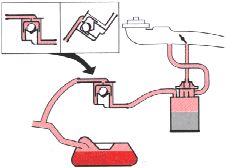
Evaporative control system
The car is equipped with a gas evaporative control system, which prevents gasoline fumes from being released into the atmosphere. The system is comprised of an expansion chamber in the fuel tank, a roll-over valve on the cross member in front of the fuel tank and a charcoal canister with a built-in vacuum valve under the left-front wheel housing. The components are interconnected by hoses which channel fuel vapor from the gas tank to the charcoal filter, where it is stored until the engine is started and then drawn into the engine's air intake system.

Crankcase ventilation
The engine is provided with positive crankcase ventilation which prevents crankcase gases from being released into the atmosphere. Instead, the crankcase gases are admitted to the intake manifold and cylinders.
PCV system
The orifice nipple in the intake manifold and the filter at the end
of the PCV hose in the air cleaner should be inspected every 60,000 miles
(96,000 km). Check/replace rubber hoses at the same time.
| pg. 8:9 Lubrication |

| No. | Lubrication point | lubricant | No. | Lubrication point | lubricant |
| 1 | Hood lock and latch | Oil | 6 | Window winder (on inside of door) | Oil, grease, low temperature grease |
| 2 | Door stop and hinges | Oil | 7 | Front seat slide rail and latch | Oil |
| 3 | Sun roof wind deflector | Oil
Low temperature grease |
8 | Door locks | Volvo teflon lock spray |
| 4 | Door lock catch plate | Oil | |||
| 5 | Trunk/tailgate lid lock | Low temperature grease |
To avoid rattles and unnecessary wear, the body should be lubricated
at regular service intervals. This should be done by an authorized Volvo
retailer.
| pg. 8:10 Engine oil |
Checking the oil level
The oil level should be checked every time the car is refuelled. This is especially important during the engine break-in period (up to the first service).
| CAUTION : Not checking the oil level regularly can result in serious engine damage if the oil becomes too low. |
Park the car on a level surface and wait for at least 3 minutes after the engine has been switched off. Be sure the oil level is maintained between the upper and lower marks on the dipstick. Low oil level can cause internal damage to the engine and over-filling can result in high oil consumption. The distance between the dipstick marks represents approx. 1 US qts (1 liter)*. The oil should preferably be checked when cold, before the engine has been started.

* Certain models: 1.6 US qts (1.5 liters)
NOTE: The engine must be stopped when checking the oil.
Draining the oil
Drain the oil after driving while it is still warm.
| WARNING! The oil may be very hot. |
If you change the engine oil and filter yourself, your Volvo retailer can assist you in disposing of the used oil. Engine oil can be harmful to your skin - gloves should worn when performing this work.
To add or change oil
Add oil of the same kind as already used. Capacity (including filter): 5.6 US qts (5.3 liters) (certain models: 6.1 US qts/5.8 liters). Turbo models: 5.6 US qts (5.3 liters).** The oil filter should be replaced at every oil change
** Add 0.95 qts (0.9 liters) if the oil cooler has been drained.
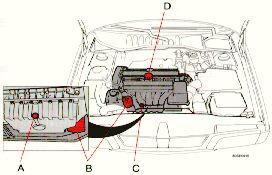
A - Drain plug, B - Oil filter, C - Oil dipstick, D - Oil filler
cap
| WARNING! Oil spilled on a hot exhaust pipe constitutes a fire risk. |
| pg. 8:11 Engine oil (cont.) |
Oil quality
Meeting API specification SG, SG/CD, SH or Energy Conserving (EC) II
For best fuel economy and engine protection consult with your authorized Volvo retailer for recommended oils. Oils with a different quality rating may not provide adequate engine protection.
Viscosity (stable ambient temperatures):
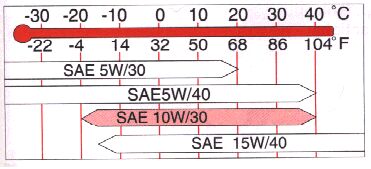
Do not use oils with other viscosity ratings. The use of incorrect viscosity
oil can shorten engine life.
Volvo recommends the use of energy-conserving oils. Look for the API
label. Synthetic oils complying with oil quality requirements are recommended
for: Driving in areas of sustained temperature extremes (hot or cold),
when towing a trailer over long distances or for a prolonged driving in
mountainous areas.
Extra oil additives must not be used unless advised by an authorized
Volvo retailer.
SAE 15W/40 is recommended for use in driving conditions that raise
oil temperature and increase oil consumption (i.e., mountain driving, trailer
towing).
NOTE: SAE 15W-40 must not be used at low ambient temperatures; see viscosity chart.
Changing oil and oil filter
Oil and oil filter changes should be made as specified in the following table:
| If driving conditions include: | Then the correct oil/oil filter change interval is: |
| • Extended periods of idling and/or low-speed operation
• Frequent short trips less than 7 miles 11 km • Extended periods of driving in dusty and/or sandy areas • Trailer towing • Driving in mountainous areas |
EVERY
5,000 miles= 8,000 km OR EVERY 6 MONTHS, WHICHEVER COMES FIRST |
| • Primarily highway driving
• Frequent trips of longer than 7 miles = 11 km |
EVERY
10,000 miles = 16,000 km 5,000 miles= 8,000 km * OR EVERY 12 MONTHS, WHICH EVER COMES FIRST |
* Turbo models
 |
American Petroleum Institute (API) labels. These labels certify the oil conforms to the applicable standards and specifications of the API. |
| pg. 8:12 Power steering fluid, Brake/clutch fluid reservoir |

Power steering fluid
The dipstick has marks for checking hot and cold oil. The oil level
when the engine is cold must never be higher than the COLD mark. After
the engine has reached normal operating temperature, the level may not
be higher than the HOT mark. Top up when the level is at the ADD mark.
Check the level at every service.
Fluid type: ATF
Replace: no fluid change required.
Brake and clutch systems
The brake and clutch systems share the same fluid reservoir. The fluid level should be between the MIN and MAX marks.
Fluid type: DOT 4+
Replace: Every second year or 30,000 miles (48,000 km). The fluid should
be replaced once a year or every 15,000 miles (25,000 km) when driving
under extremely hard conditions (mountain driving, etc.)
Check, without removing the cap, that the level is above the " MIN "
mark of the fluid reservoir.
Always entrust brake/clutch fluid changing to an authorized Volvo retailer.
*At owner request
| pg. 8:13 Automatic transmission fluid |

Check the oil level as follows:
Park the car on a level surface with the engine idling . Slowly move
the gear selector lever through all the shift positions and then to position
P. Wait 3 minutes before checking the oil level.
As the illustration shows, the dipstick has a COLD and a HOT side.
The oil level should between the MIN and MAX marks. Wipe the dipstick with
a clean cloth.
| WARNING! The oil may be very hot. |
Do not use rags that could leave lint on the dipstick. The transmission is topped up via the dipstick tube. The space between the MIN and MAX marks on the dipstick corresponds to 0.5 US qt. (0.5 liter). Do not fill the transmission with too much oil, since this can result in oil being ejected from the transmission. Too little oil, on the other hand, can negatively affect transmission operation, particularly in very cold weather.
A Cold transmission: oil temperature 105° F (40° C). This is
a normal temperature for the transmission after idling for about 10 minutes.
At oil temperatures below 105° F (40° C), the level may be below
the MIN mark.
B Warm transmission: oil temperature 169° F (80° C). This temperature
after driving for about 30 minutes. At oil temperatures above 190°
F (90° C), the level may be above the MAX mark.
Fluid type: ATF Dexron IIE/III and Mercon.
| WARNING! Oil spilled on a hot exhaust pipe constitutes a fire risk. |
| pg. 8:14 Drive belt, Air pump system |
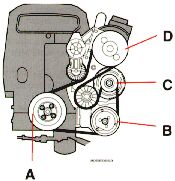
A - crankshaft, B - A/C compressor,
C - generator, D - power steering pump
Belt check
Check the belt regularly to make sure it is in good condition and is clean. A worn or dirty belt can cause poor cooling and low generator output as well as impair the operation of the power steering and the air conditioning unit.
NOTE : The belt on the 850 is equipped with a self-tensioning mechanism and requires no adjustment between changes.
| WARNING! The engine must not be running when this check is performed. |
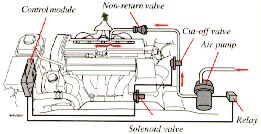
Air pump system (B5254S)
When the engine is being started from cold, an electrical air pump which
draws air to the exhaust system is activated. This starts an afterburning
process which leads to reduced hydrocarbon and carbon monoxide (HC and
CO) emissions and reduces the warm-up period for the catalytic converter.
The pump starts when the car has been started and is moving. It continues
to work until the catalytic converter has reached normal working temperature,
although it can also start when the engine is idling. If the air pump is
running and the engine is switched off, the pump continues working in order
to protect the pump motor.
Note! A soft whining noise can be heard from the pump, and when it
performs a self-diagnosis, the high/low beam and the instrument lighting
will flash briefly. This is completely normal.
| pg. 8:15 Windshield washer nozzles, Washer fluid reservoir |
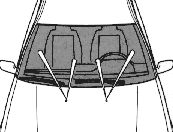
Adjusting washer nozzles
The washer jets should spray the windshield as shown above. Use the edge of a small screwdriver to adjust the nozzles if necessary.

Washer fluid reservoir
The washer fluid reservoir is located in the engine compartment and
holds approx. 3.2 US qts. (3.0 liters).
During cold weather, the reservoir should be filled with windshield
washer solvent containing anti-freeze.
| pg. 8:16 Coolant |
Check coolant level
The cooling system must be filled with coolant and not leak to operate
at maximum efficiency. Check the coolant level regularly. The level should
be between the "MAX" and "MIN" marks on the expansion tank. The check should
be made with particular thoroughness when the engine is new or when the
cooling system has been drained.
Do not remove the filler cap other than for topping up with coolant.
Frequent removal may prevent coolant circulation between the engine and
the expansion tank during engine warm up and cooling.
Changing coolant

Normally, the coolant does not need to be changed. If the system must
be drained, use the following procedure:
1 Remove the expansion tank cap.
2 Move the temperature adjustment control to max. heat. Open the drain
cocks at the rear left of the engine block and at the bottom right corner
of the radiator.
3 Disconnect the lower right radiator hose.
Filling:
4 Close the drain cocks and reconnect the hose.
5 Fill the expansion tank to the MAX mark or slightly above.
6 Run the engine until hot. Check the cooling system connections for
tightness. Recheck the coolant level.
Capacity: Approx. 7.6 US qts. (7.2 liters)
Turbo - 7.4 US qts. (7.0 liters)
Coolant: Volvo Genuine Coolant/Antifreeze only
NOTE: Do not top up with water only. Water by itself reduces the rust-protective and anti-freeze qualities of the coolant and has a lower boiling point. It can also cause damage to the cooling system if it should freeze.
| WARNING: If the engine is warm and you are going to top up coolant, unscrew the cap slowly in order to allow any excess pressure to escape. |
| CAUTION: The cooling system must always be kept filled to correct level. If it is not kept filled, there can be high local temperatures in the engine which could result in damage. Different types of anti-freeze/coolant may not be mixed. |
| pg. 8:17 Engine compartment |
Engine compartment 850
(engine B 5254 S / B 5252 S)
1 Expansion tank, coolant
2 Engine designation plate
3 Oil filler cap, engine
4 Clutch/brake system fluid reservoir
5 Fuse box
6 Washer fluid reservoir
7 Power steering fluid reservoir
8 Dipstick - engine oil
9 Dipstick - automatic transmission
10 Air cleaner
11 Battery
12 Data plate
| WARNING! The cooling fan may start or continue to operate (for up to 6 minutes) after the engine has been switched off. |
| pg. 8:18 Engine compartment (cont.) |
Engine compartment 850 Turbo
(engine B 5234 T)
1 Expansion tank, coolant
2 Engine designation plate
3 Oil filler cap, engine
4 Clutch/brake system fluid reservoir
5 Fuse box
6 Washer fluid reservoir
7 Power steering fluid reservoir
8 Dipstick - engine oil
9 Dipstick - automatic transmission
10 Air cleaner
11 Battery
12 Data plate
| WARNING! The cooling fan may start or continue to operate (for up to 6 minutes) after the engine has been switched off. |
|
|